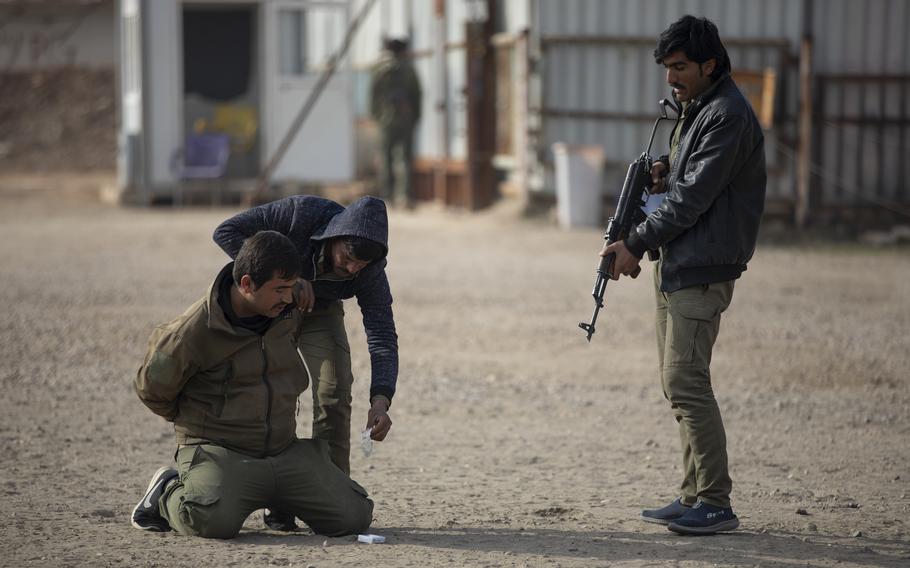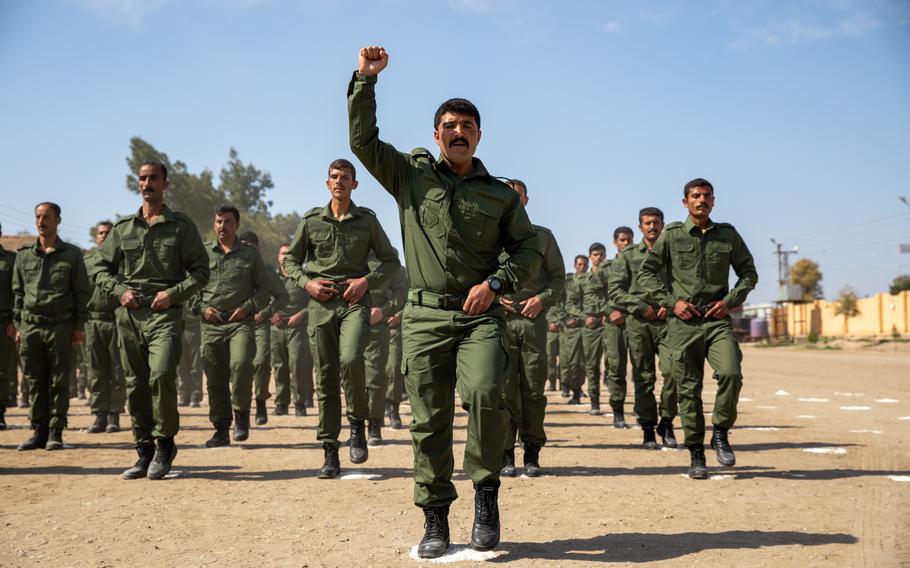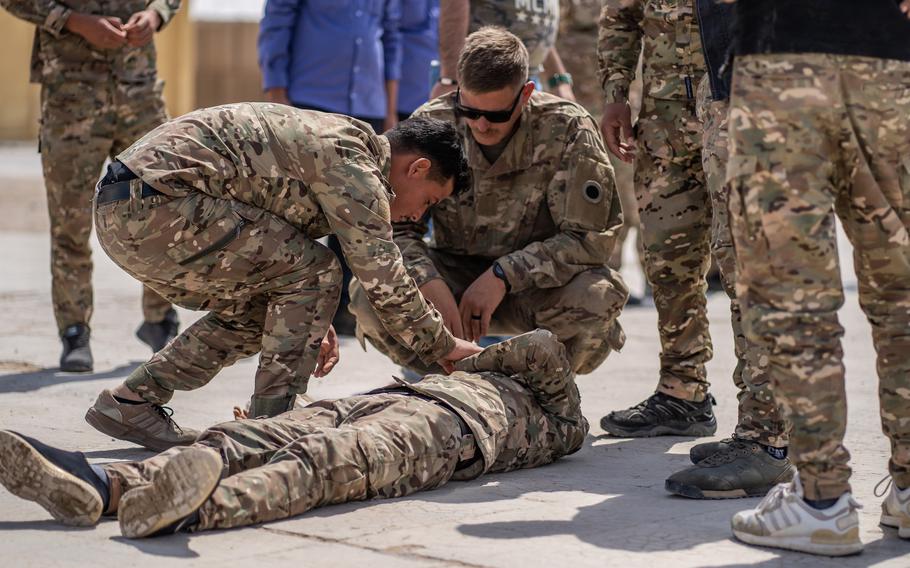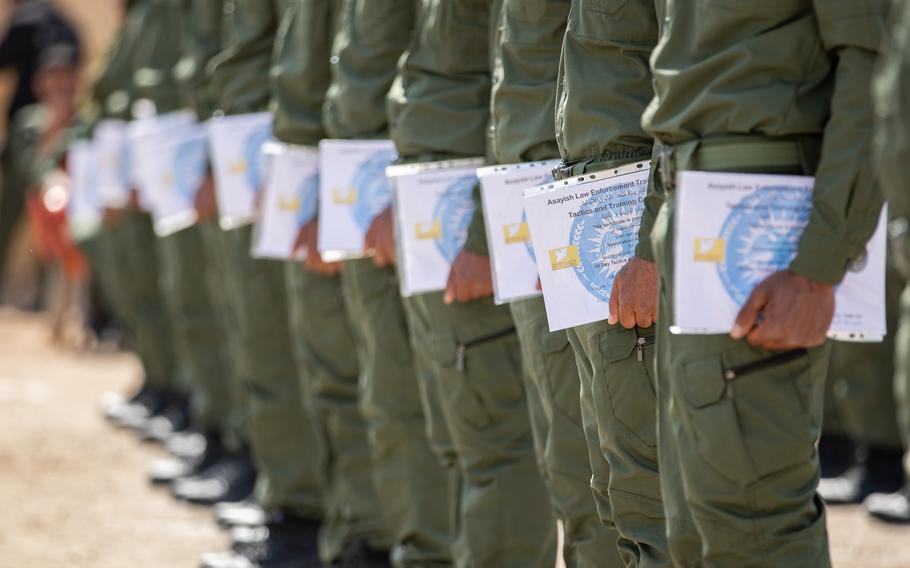
Syrian students at Asayish training academy demonstrate a suspect search during an exercise in the al-Hasakah region of Syria on Dec. 22, 2022. The U.S. military recently reported a lack of progress in certain efforts to train security forces in Iraq and Syria to fight the Islamic State. (Nicholas J. De La Pena/U.S. Army)
The U.S. military is reporting paltry progress in some of its efforts to train security forces in Iraq and Syria to fight the Islamic State, which some analysts say raises concerns of a potential repeat of past military collapses.
U.S.-trained forces in Iraq made “no notable gains in counter-ISIS capability” as part of these efforts, known as Operation Inherent Resolve, said a recent report to Congress.
Those groups also remain largely dependent on American airpower and are having trouble recruiting for one of their most elite units, said the report by the lead inspector general for Operation Inherent Resolve.
Meanwhile, U.S. partner forces in Syria have been susceptible to bribes and are distracted from the mission against ISIS because of attacks from Turkey, said the report, which was released in early August.
These factors put U.S. efforts in the two countries on a concerning trajectory, said Jonathan Lord, a senior fellow at the Center for a New American Security.
He and others likened issues identified in the report to mistakes in previous U.S. attempts to train local security forces. These failures led to the implosions of the Iraqi military in 2014 against ISIS and the Afghan military in 2021 against the Taliban.
“If all we have done is what we are doing now, we’re going see this collapse occur again,” Lord said this week. “We’ve seen this movie; let’s not replay the sequel.”

Syrian training academy members march during a graduation ceremony in the al-Shaddadi region of Syria on April 3, 2023. U.S. partner forces in Syria have been susceptible to bribes and are distracted from the mission against the Islamic State by attacks from Turkey, an inspector general report assessed in August. (Nicholas J. De La Pena/U.S. Army)
The U.S. has been fighting ISIS since the militant group conquered about a third of Syria and 40% of Iraq in 2014.
About 900 American service members are in Syria as part of joint efforts with Kurdish fighters to prevent an ISIS resurgence, the military said earlier this year.
Roughly 2,500 troops are deployed to Iraq, where they officially act only in an advisory role because the U.S. combat mission there ended in 2021.
Congress allotted $5.5 billion for these efforts for fiscal year 2023, said the inspector general report.
Advisers noted that Iraq’s Counterterrorism Service, the country’s elite special operations unit, has not been able to recruit any new personnel since 2018, the report said.
The unit has 16,506 members, only 43% of its allotted strength, a situation that is particularly concerning to some experts.
Furthermore, coordination between the Iraqi Security Forces and the Kurdish Security Forces is stagnant, the inspector general found.

A Syrian Internal Security Forces student checks for a pulse on a simulated casualty during instruction in al-Hasakah province, Syria, on May 6, 2023. (Nicholas J. De La Pena/U.S. Army)
The Iraqi air force continues to rely on U.S. assistance to identify targets for airstrikes, and the need for English proficiency for aviators has been an obstacle in recruitment efforts, the report said, echoing previous concerns about efforts to train Afghan pilots.
Maj. Geoffrey Carmichael, an Operation Inherent Resolve spokesman, acknowledged that some partners are making less progress than others, but he said ISIS has been weakened considerably.
“Overall, the model is working,” Carmichael said in a statement Thursday.
The number of ISIS attacks from April to June was down 70% from the same period last year, the inspector general report said. Most of those attacks were small and opportunistic, and financial difficulties are preventing the group from consistently paying its fighters, the report said.
But analysts describe a worrisome long-term outlook for the U.S. in Iraq and especially Syria.
While the Islamic State is weakened significantly, it could return to power in the right situation, both they and military officials have said.
Some 10,000 ISIS fighters are detained in facilities across northeastern Syria, guarded by the Syrian Democratic Forces, a U.S. partner. But the Kurdish-led group is limited in size and vulnerable to bribery, the inspector general said.
And the Syrian Democratic Forces are distracted from the fight against ISIS because they need to fend off attacks from Turkey, the report said.
Although it is a U.S. ally, Turkey does not differentiate between the Syrian Democratic Forces and the Kurdish Workers Party, a U.S.-designated terrorist group.

Syrian training academy members hold certificates of completion during a graduation ceremony April 3, 2023. (Nicholas J. De La Pena/U.S. Army)
The complex geopolitical landscape further complicates the situation. Russian and U.S. forces are in Syria with the declared mission to fight the Islamic State group, but they back opposing armed groups.
The U.S. repeatedly has accused Russia of flying its fighter jets over U.S. bases.
Iran-aligned militias also have attacked U.S. and coalition forces in Syria with drones and rockets. One such attack in March killed a U.S. contractor and injured 25 troops.
American and coalition troops have reallocated surveillance systems from counter-ISIS operations to defense, the report said.
Analysts urged the need to learn from past mistakes in Iraq and Afghanistan if partner forces are to survive should U.S. troops leave.
This means that the U.S. should adopt a long-term strategy that tries to diplomatically address issues such as the conflict between Turkey and the Kurds, poor governance in Iraq, and Russian and Iranian influence in the region, analysts said.
Instead, the Pentagon seems more concerned with the number of ISIS attacks or how many of the group’s leaders are killed, said Brian Carter, an analyst at the American Enterprise Institute.
“We are focusing on knocking out the top leaders,” Carter said. “The problem is this isn’t going to lead to lasting success.”